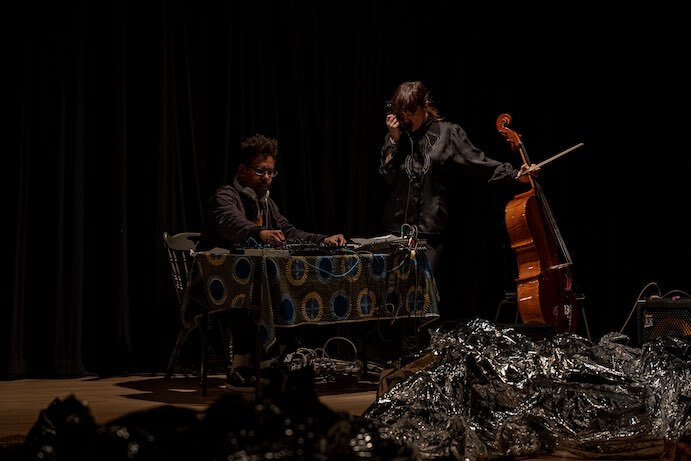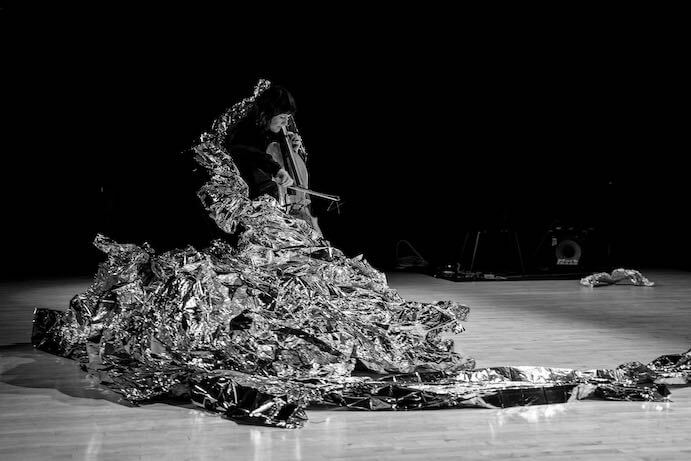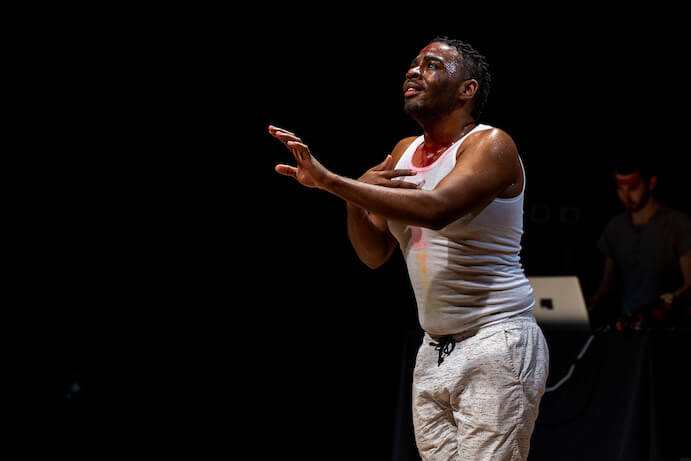On Sunday, March 1, 2020, the Frequency Festival, in its fifth year programming contemporary and experimental music for Chicago audiences, closed with a performance from cellist Katinka Kleijn and vocalist Julian Otis. This year’s Frequency Festival featured artists from across the globe performing in venues across the city. However, it was fitting that the closing concert of Frequency 2020 was something of a homecoming. Concert-goers arrived at Constellation, the venue that originated the series, to hear two performers with Chicago roots. Friends gathered together and greeted one another, recognizing each other from over the course of the week’s festival events, or over years on the Chicago contemporary music scene.
The stage was set with heaps of reflective silver mylar, draped all over the floor and gathered in little piles, which Katina Kleijn had to step into to begin her set. She painted a sonic landscape with ringing harmonics and portamentos that build into an arc in Dai Fujikura’s osm. Watching Kleijn perform is like watching a magician slowly reveal her bag of tricks. She relies not only on her technical virtuosity, but also her willingness to utilize her body, voice, and exploration of sound. She demonstrated this when she joined sound artist Damon Locks in his new electro-acoustic work The Sonic Life, which saw Kleijn using extended techniques to create otherworldly sounds over the comparatively more familiar sounds of conversation and a hi-hat beat in the electronic track. The piece ended with Kleijn putting aside her instrument to speak poetry into a phone’s receiver, her voice distorted by Locks to sound far away, as if from another planet.

Among the highlights of the program was a world premiere of Aliya Ultan’s Residuum for Cello and 600 feet of Mylar, in which Kleijn merged the sounds of her instrument with the rustling foil onstage. Turning around while bowing the instrument in a kind of dance, Kleijn gradually wrapped the foil around her feet, then her legs, then arms and torso, gowning herself in silver reflective material. Then, suddenly, she stepped out of the material, leaving her still-resonating cello draped in foil, revolving like a disco-ball, leaving the audience unsure whether to chuckle appreciatively or to sit back in awe of the spectacle. It’s a delight to hear and to see, and clearly a joy for the artists, given the way Ultan leapt from the audience into Kleijn’s arms during the applause.
But the magician was not finished yet. Kleijn closed her set with another premiere, this time of Nathan Davis’ Caveau Phonocamptique for cello and electronics. The piece began with Kleijn tucking a cloth under a string, dampening it so all that can be heard was the whisper of the bow. Then, just as the audience was leaning in to hear it better, abracadabra, presto! She removed the cloth to reveal a pitch, resonant and delicate. Kleijn’s performance showcased a vast range of talents, and yet at no point was I left with the sense that she had exhausted her all of her skills.

Following the intermission, Julian Otis led a performance set that was visceral and raw. Otis, an up-and-coming vocalist making a name for himself in and around Chicago, is the kind of performer that can convey more emotion in a single consonant than many can in a whole aria. And he is at full force when he uses whispers, grunts, growls, and screeches to make his point. He performed his set without pause, creating a story that was as much performance art as it was musical. Particularly moving was Anthony R. Green’s Empathy I: Diamond Reynolds, which the composer described as “an opportunity to process the inner emotional life of Reynolds’s witness to the death of her boyfriend, Philando Castile.” Indeed, with the incorporation of movement and shocking, wordless vocalisms, it really did feel like a catharsis. Otis hurled sounds at the audience like accusations before being joined by co-devisers Margaret Morris and Scott Rubin for Intercession.

Otis and Morris used movement to cajole, comfort, and instigate. The two showcased their athleticism as well as their willingness to go there, to be the mirror that reflected some of the most uncomfortable emotions. And yet, rather than leave the performance to drown there, the artists lead the audience back from the brink. They closed their set by inviting the audience to come into their space, to be present in the moment and bear witness to grief at its sharpest. Some even leapt out of their seats to join them on stage. Their set revealed what the blend of performance art and social commentary can be when it is put into the hands of extremely capable artists. Katinka Kleijn and Julian Otis—the magician and the mirror—exemplify what Chicago has to offer when it comes to artists who who experiment with their craft and stretch the boundaries of their genre.
























